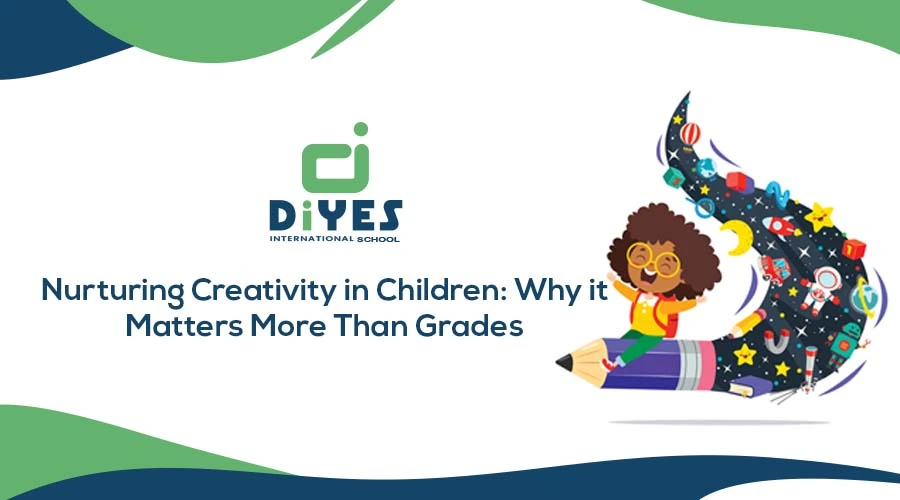In the pursuit of academic excellence, the significance of nurturing creativity in children often takes a backseat. However, creativity is not merely an optional trait; it is a fundamental aspect of human expression and problem-solving that shapes the way we perceive and interact with the world. This blog delves into the profound importance of nurturing creativity in children and why it holds greater value than grades alone.

Creativity in children is a vital aspect of their development, nurturing imagination, innovation, and problem-solving abilities from a young age. By prioritizing nurturing creativity in children, we can unlock their full potential and equip them with skills that transcend traditional academic measures.
This blog explores the vital role of nurturing creativity in children, emphasizing its significance beyond academic performance. The importance of nurturing creativity in children cannot be overstated, as it empowers them to think critically, explore new ideas, and express themselves creatively. In early childhood education, prioritizing the nurturing of creativity lays a foundation for lifelong learning and innovation, setting children on a path towards realizing their creative potential. Through various educational strategies and practical examples, we illustrate how prioritizing creativity benefits children’s holistic development and prepares them for the challenges of the future.
Encouraging Divergent Thinking
Encouraging divergent thinking is crucial for children as it allows them to explore multiple solutions to a problem, nurturing innovation and originality. Divergent thinking promotes flexibility, creativity, and the ability to generate unconventional ideas, which are essential skills in today’s rapidly changing world.
- Exploring Multiple Perspectives: By encouraging children to consider various viewpoints and approaches, they develop empathy, critical thinking, and the ability to see beyond the obvious. This enables them to approach challenges with a broader perspective and consider innovative solutions that may not be immediately apparent. When children learn to appreciate diverse perspectives, they become more open-minded and adaptable, qualities that are highly valued in today’s global society.
- Encouraging Curiosity and Exploration: Cultivating a sense of curiosity inspires children to question, experiment, and discover new ideas. When children are encouraged to explore their interests and pursue their curiosity, they develop a lifelong love for learning and a thirst for knowledge that drives them to seek out new experiences. By nurturing curiosity, parents and educators lay the foundation for a lifetime of learning and discovery.
- Accepting Mistakes as Learning Opportunities: Creating a safe environment where mistakes are viewed as opportunities for growth is crucial for nurturing divergent thinking. When children feel comfortable taking risks and making mistakes, they become more resilient and willing to explore unconventional solutions to problems. By reframing mistakes as valuable learning experiences, parents and educators encourage children to accept challenges and push the boundaries of their creativity.
Adopting divergent thinking nurtures children’s creativity and equips them with the skills needed to tackle complex challenges with confidence and ingenuity. By nurturing an environment that values curiosity, exploration, and experimentation, parents and educators can empower children to approach problems with an open mind and welcome the endless possibilities that lie ahead.
Nurturing Creative Expression
Providing outlets for creative expression is vital for children as it allows them to communicate their thoughts, emotions, and experiences in meaningful ways. When children are encouraged to express themselves creatively, they develop a deeper understanding of themselves and the world around them. Creative expression nurtures self-awareness, emotional intelligence, and resilience, which are essential skills for navigating life’s challenges.
- Encouraging Arts and Imagination: Engaging in artistic activities such as drawing, painting, and storytelling stimulates children’s imagination and self-expression. Through creative outlets, children can explore their emotions, express their ideas, and develop their unique artistic voice. Artistic activities also provide opportunities for children to experiment with different mediums and techniques, nurturing creativity and innovation.
- Promoting Creative Play: Unstructured playtime encourages children to explore, experiment, and invent, nurturing creativity, problem-solving, and social skills. When children engage in creative play, they learn to think outside the box and approach challenges with curiosity and imagination. Play allows children to test out new ideas, take risks, and learn from their experiences in a safe and supportive environment.
- Multimodal Communication: Supporting children in expressing themselves through various mediums, including visual arts, music, and drama, enhances their communication skills and emotional intelligence.

When children are encouraged to communicate in different ways, they develop a deeper understanding of themselves and others. Multimodal communication also allows children to express complex ideas and emotions that may be difficult to articulate verbally.
Nurturing creative expression empowers children to communicate their ideas and emotions effectively, nurturing confidence, self-awareness, and resilience. By providing opportunities for children to engage in artistic activities, creative play, and multimodal communication, parents and educators can help children develop the skills and confidence needed to express themselves authentically and creatively.
Cultivating a Growth Mindset
Cultivating a growth mindset teaches children to accept challenges, persist in the face of setbacks, and view failures as opportunities for learning and growth. By nurturing a growth mindset, children develop resilience, confidence, and a belief in their ability to learn and grow. A growth mindset is essential for success in school, career, and life, as it encourages children to take risks, overcome obstacles, and pursue their goals with determination and perseverance.
- Encouraging Perseverance and Resilience: Teaching children to persevere through challenges and setbacks builds resilience, grit, and determination, essential qualities for overcoming obstacles and achieving success. When children learn to accept challenges as opportunities for growth, they become more resilient and adaptable in the face of adversity. Perseverance teaches children that success is not always immediate and requires effort and determination over time.
- Instilling Confidence and Self-Efficacy: Nurturing a belief in one’s ability to learn and improve instills confidence and self-efficacy, empowering children to take on new challenges and pursue their passions. When children develop a growth mindset, they become more confident in their abilities and more willing to take risks in pursuit of their goals. Self-efficacy is essential for building a sense of agency and control over one’s life, as it encourages children to take initiative and advocate for themselves.
- Celebrating Effort and Progress: Recognizing and celebrating children’s efforts and progress, rather than focusing solely on outcomes, reinforces the value of hard work, perseverance, and continuous improvement. When children receive praise and encouragement for their efforts, they develop a sense of pride and accomplishment that motivates them to continue striving for excellence. By celebrating progress, parents and educators create a supportive environment where children feel valued, respected, and motivated to succeed.
Cultivating a growth mindset nurtures children’s resilience, confidence, and determination, empowering them to accept challenges, overcome setbacks, and achieve their goals. By nurturing an environment that values effort, perseverance, and continuous improvement, parents and educators can help children develop the mindset and skills needed to excel in school, career, and life.
Encouraging Innovative Problem-Solving
Encouraging innovative problem-solving empowers children to think creatively, analyze situations from different perspectives, and devise effective solutions. In today’s rapidly changing world, creative problem-solving skills are essential for navigating complex challenges and finding innovative solutions to pressing issues.
- Nurturing Critical Thinking Skills: Providing opportunities for children to critically analyze problems, brainstorm ideas, and evaluate potential solutions enhances their problem-solving abilities and decision-making skills. When children learn to think critically, they become more adept at identifying root causes, analysing information, and developing effective strategies for solving problems. Critical thinking skills are essential for success in school, career, and life, as they enable children to make informed decisions and solve problems creatively.
- Promoting Collaboration and Teamwork: Encouraging children to work collaboratively in solving problems nurtures communication, cooperation, and collective problem-solving skills. When children collaborate with others, they learn to share ideas, listen to different perspectives, and work towards common goals. Collaboration also teaches children valuable social skills such as communication, teamwork, and conflict resolution, which are essential for success in today’s interconnected world.
- Trial and Error: Creating a supportive environment where children feel comfortable experimenting, taking risks, and learning from failures encourages innovative thinking and resilience.

When children are encouraged to accept failure as a natural part of the learning process, they become more willing to take risks and explore unconventional solutions to problems. By reframing mistakes as valuable learning experiences, parents and educators inspire children to persevere through challenges and develop creative problem-solving skills.
Encouraging innovative problem-solving empowers children to tackle challenges creatively, collaborate effectively, and adapt to changing circumstances, preparing them for success in the 21st century. By nurturing an environment that values creativity, collaboration, and resilience, parents and educators can help children develop the skills and mindset needed to excel in an increasingly complex and interconnected world.
Conclusion
In nurturing creativity in children, we start on a journey that transcends conventional measures of success, welcoming the boundless potential of young minds to innovate, express, and problem-solve. By adopting divergent thinking, we provide children with the tools to explore multiple solutions, nurturing a spirit of curiosity and ingenuity that fuels their creative endeavours. Through encouraging exploration of various perspectives and approaches, we lay the groundwork for empathetic, critical thinkers who approach challenges with resilience and adaptability.
Furthermore, nurturing creative expression offers children a means to communicate their thoughts, emotions, and experiences in meaningful ways, promoting self-awareness, emotional intelligence, and resilience. By providing outlets for artistic activities, imaginative play, and multimodal communication, we empower children to express themselves authentically and creatively, nurturing confidence and self-expression. This not only enriches their personal development but also equips them with essential skills for navigating the complexities of the modern world.
Cultivating a growth mindset and encouraging innovative problem-solving are pivotal in empowering children to overcome obstacles, accept challenges, and pursue their goals with determination and perseverance. By instilling a belief in their ability to learn and improve, celebrating effort and progress, and nurturing collaboration and resilience, we equip children with the mindset and skills needed to excel in an ever-evolving landscape. Ultimately, by nurturing creativity in children, we lay the foundation for a future generation of innovators, creators, and changemakers poised to shape a brighter tomorrow.
At DiYES International School, our commitment to nurturing creativity in children goes beyond academics; it’s about nurturing their spirits, igniting their passions, and guiding them to discover the magic within themselves. We believe that every child is born with a unique spark of creativity, and it’s our mission to fan that flame, allowing it to illuminate their path with boundless possibilities.
In the halls of our school, we see more than just classrooms and textbooks; we see stages for young minds to dream, explore, and create. We witness moments of inspiration, laughter, and discovery, knowing that each one is a testament to the vibrant tapestry of creativity that flourishes’ within our students. It’s in these moments that we see the true essence of education – not just the imparting of knowledge, but the nurturing of the soul.
As we continue on this journey with our students, we hold fast to the belief that creativity is not just a skill to be taught, but a gift to be cherished. It’s the spark that ignites their imagination, the fuel that propels them forward, and the beacon that guides them towards a future filled with endless possibilities.
For more information about nurturing creativity in children and our holistic approach to education, visit our website at www.diyesinternational.edu.in or contact us at +918547609000.


